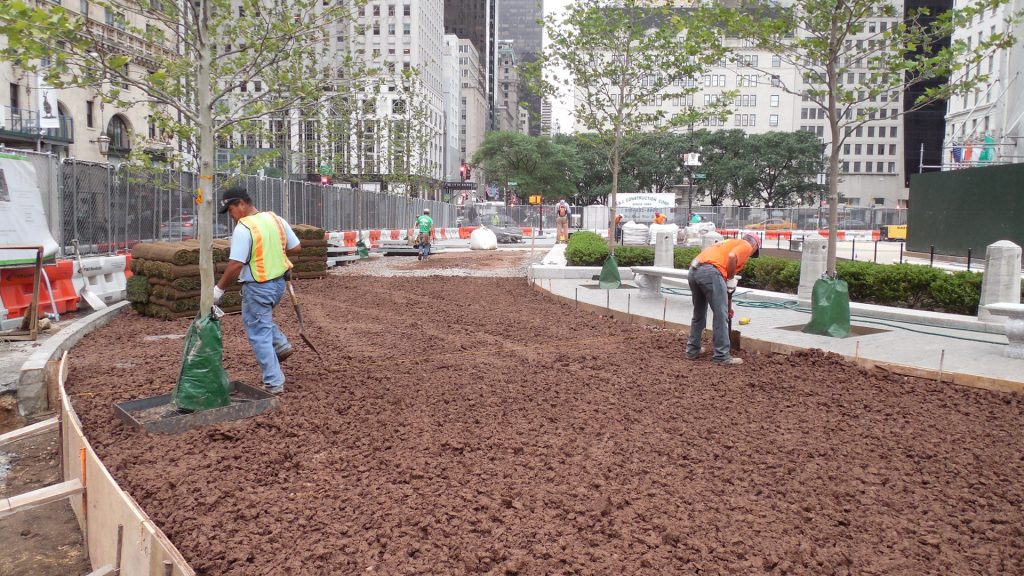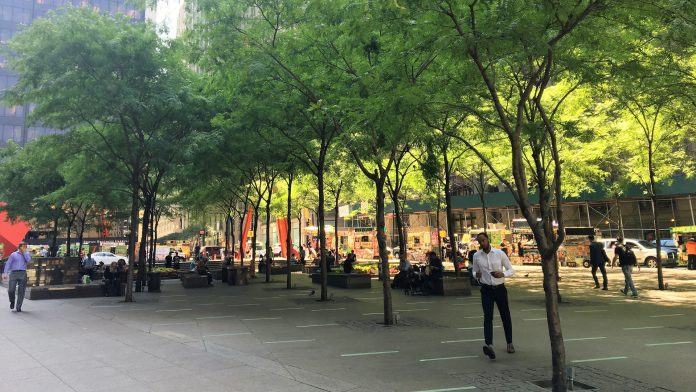The fact that trees have difficulties surviving in urban environments is not a surprise. Urban areas are rarely designed with trees in mind.
Trees are often treated as if they were afterthoughts in an environment designed and built for cars, pedestrians, buildings, roadways, pavements and carparks. Urban trees face a range of environmental challenges, such as increased heat loads, de-icing salts, soil and air pollution; and interference from utilities, vehicles and buildings. Yet the most significant problem that urban trees face is the scarcity of soil suitable for root growth.
While many of the problems faced by urban trees can be mitigated by planting species which are tolerant of a given challenge, there are no tree species which can tolerate the extreme soil compaction that is prevalent throughout urban and suburban landscapes.
A large volume of uncompacted soil, with adequate drainage, aeration and reasonable fertility, is the key to the healthy growth of trees. The upfront investment in making the soil suitable for supporting a healthy tree is paid back in full when that tree fulfils the functions for which it was planted. These functions may include shade, beauty, noise reduction, wind abatement, pollution reduction, stormwater mitigation, wildlife habitat; and the creation of civic identity. An adequate soil volume is key, considering that soils are where levels of nutrients, water and air are sufficiently balanced to allow for root growth and the acquisition of water and nutrients. Simply put, when soils are inadequate, plant growth suffers and trees die prematurely.
Human activities can severely damage soil structure. The process of construction in a city, or even the installation of a pavement in an otherwise rural area, necessarily dictates a high level of soil disturbance. Any construction effort requires soil excavation, cut and fill, re-grading and soil compaction. Often heavy machinery is brought on site to accomplish this work, increasing the potential for compaction of soils. There are two critical effects of soil compaction which directly impact plant growth and limit usable rooting space:
- Soil structure is destroyed and the majority of large interconnected pores (macropores) are crushed. This results in a restriction of the soil’s water drainage and subsequent aeration; and
- As the macropores are crushed, soils become denser, eventually posing a physical barrier to root penetration. There are numerous accounts of urban soils being literally as “dense as bricks”.
What happens when roots encounter dense, compacted soil?
When roots encounter dense soil they change direction, stop growing, or adapt by remaining abnormally close to the surface. This superficial rooting makes urban trees more vulnerable to drought stress and can cause pavement heaving. Also, if a dense soil becomes waterlogged, the tree roots can rot from lack of oxygen.
In urban soils which are not covered by pavement, it is possible to break up, augment or replace compacted soils to make them more conducive to root growth. However, where soils are covered by pavement, the needs of the tree come in direct conflict with infrastructure specifications which call for a highly compacted base on which to construct pavement. All pavements must be laid on well-draining compacted bases so that the pavement will not subside, frost heave, or otherwise prematurely require replacement. Therefore, soils supporting pavement are often too dense for root growth. It is not surprising, then, that urban trees surrounded by pavement have the shortest life spans of trees in cities. Unfortunately, these paved areas also tend to be those in the most need of trees to mitigate the heat island microclimates which occur in downtown areas. Urban trees are necessary to the health and liveability of our cities.
Where can one find enough soil?
If the soil under pavements and other paved areas were suitable for root growth, urban trees would potentially have access to large volumes of soil. This scenario would allow trees to grow to their mature size and perform as desired. Additionally, if the soil volume for each tree were connected and continuous, each tree would be able to share soil with its neighbours. Looking at the forest as a model, trees may be spaced reasonably close together as long as they share a large common volume of soil to support their needs.
Given the limited space availability in cities, it is highly desirable to be able to have soil which can meet paving engineering requirements, while simultaneously allowing for unimpeded root growth under the pavement. CU-Structural Soil™ is one technology that meets these requirements.
What is CU-Structural Soil?
CU-Structural Soil is a two part system comprised of a rigid stone ‘lattice’, which meets engineering requirements for a loadbearing paving base; and a quantity of uncompacted soil to support tree root growth. The primary component of this soil system is a uniformly sized, highly angular crushed stone ranging from 2 to 4 cm in diameter with no fine materials. When this single sized stone is compacted, the stones form an open lattice structure with about 40% porosity. Friction at the points where stones come in contact with one another cause the stones to ‘lock in,’ creating the loadbearing structure of the CU-Structural Soil.
The second component of the system is a soil which fills the voids in the stone lattice. As long as care is taken to not add too much soil to the mix, which would prevent the stone structure from forming, the soil in the voids will remain uncompacted and penetrable by tree roots. Because among soil textures clay has the most water and nutrient holding capacity, a heavy clay loam or loam with a minimum of 20% clay is used in the CU-Structural Soil system. It should also have organic matter content ranging from 3% to 5% to ensure nutrient and water holding while encouraging beneficial microbial activity.

With carefully chosen uniformly graded stone and the proper stone-to-soil ratio, a medium for healthy root growth is created which also can be compacted to meet engineers’ loadbearing specifications. The intention is to effectively suspend the clay soil between the stones without overfilling the voids, which would compromise both the soil’s aeration and loadbearing capacity.
The structural soil process further benefits from adding a tackifying agent to stabilise the mixing process. The tackifier allows the stones and soil to mix uniformly and prevents the separation of the materials which can occur as a result of vibration in transit, dumping and working of the material in installation.
Since its development at Cornell University’s Urban Horticulture Institute in the late 1990s, there have been over 2,400 installations of CU-Structural Soil throughout the entire United States, Canada and parts of Europe – in all cases, resulting in a greener, healthier inner city.








